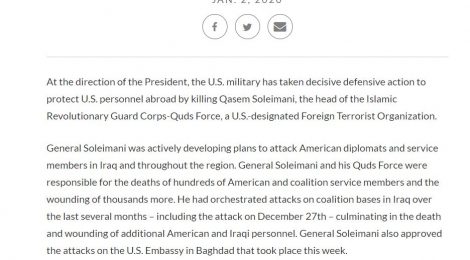
America Responds to Iranian Provocations With Massive Force
America Responds to Iranian Provocations With Massive Force
See also: Timeline of 2019-2020 U.S.-Iran Crisis
On January 2, 2020 (Jan. 3 in Iraq), the United States killed an Iranian military leader who had orchestrated terrorist and proxy attacks on the U.S., Israel, Saudi Arabia, and other anti-Iranian targets for decades. What this means for the overall Middle East conflict is as yet unclear, though oil prices did surge on the news. In terms of the political and military situation in Iraq and the Gulf region in general, it largely depends on how Iran and her proxy forces in Iraq (i.e. the Shiite militias that they control), respond.
While it is likely that the U.S. decision to attack the Shiite militia bases was intentionally done by Iran in order to redirect Iraqi protest from anti-Iranian to anti-American, it is apparent that Iran bit off more than it expected, as they have now lost Quds Force General Qassem Soleimani and a couple of major Kata’ib Hezbollah commanders in the U.S. airstrike at the Baghdad Airport. Soleimani led the Quds Force, a part of the Iranian Revolutionary Guards. The Quds Force’s role is to export the Iranian Revolution and Tehran’s brand of Shiite Islamic fundamentalism. To that end, Soleimani led the Quds Force in terrorist attacks on American and Israeli targets, orchestrated Iran’s interventions in Syria and Yemen, and, during the Iraq War, he directed the Shiite militias that fought U.S. Forces. An estimate by the U.S. government places Soleimani’s Quds Force as being responsible for over 600 U.S. military deaths in that conflict, or nearly 17% of total American fatalities in the Iraq War.
President Trump, in ordering the strike on Soleimani, took out a major player in Iran’s war on the West and America’s allies. To quote Senator Ben Sasse, of Nebraska, “General Soleimani is dead because he was an evil bastard who murdered Americans.” This is a pretty accurate description of Soleimani. The big question now is, what will Iran and her proxy forces in the Middle East do now?
The Shiite militias command thousands of battle-hardened fighters, in both Iraq and Syria, where the U.S. still has about a thousand troops. The U.S. Embassy in Baghdad is an obvious target, but has been reinforced by the U.S. Marines. More Iranian drone attacks on Saudi oil targets would be disruptive, but would then put Iran’s oil infrastructure on the firing line as well. Iran must now realize that President Trump WILL respond with force, and not in a one-to-one response, but with overwhelming force. In the December 27 rocket attacks, one American civilian contractor was killed and four American soldiers wounded. In reply, the U.S. took out over two dozen Shiite militia fighters, an Iranian general, and two Iraqi Shiite militia leaders. It should be obvious that further Iranian or Iranian-inspired attacks will result in exponential retaliation.
